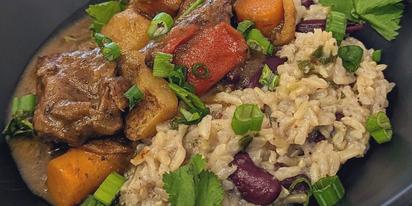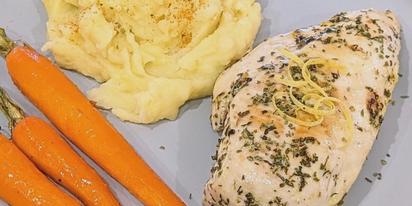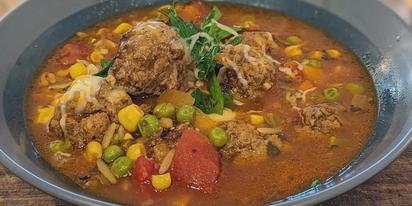
My local grocery store was having a sale on standing rib roasts with the bone already trimmed and easy to remove. They called it a “Boned and Tied Standing Rib Roast.”
I couldn’t resist picking one up, but I didn’t know what to do with it.
So, I reached out to Gippity for some inspiration.
The Prompt
Sup, Gippity. What are some different ways to prepare a standing rib roast?

Gippity Kitchen Says:
Ah, standing rib roast. This prime cut of beef, known for its rich flavor and tender texture, can be the star of any dining occasion.
Here are a few different ways to prepare a standing rib roast, each bringing out unique flavors and textures. Let me know which one calls to you:
Classic Oven Roasted
This is a traditional method that emphasizes the meat’s natural flavors. Season the roast generously with salt, pepper, and herbs like rosemary and thyme. Let it sit at room temperature for about an hour. Preheat your oven to 450°F (230°C), roast for about 20 minutes, then lower the heat to 350°F (175°C) and continue roasting until it reaches your desired doneness. Let it rest before slicing to retain its juices.
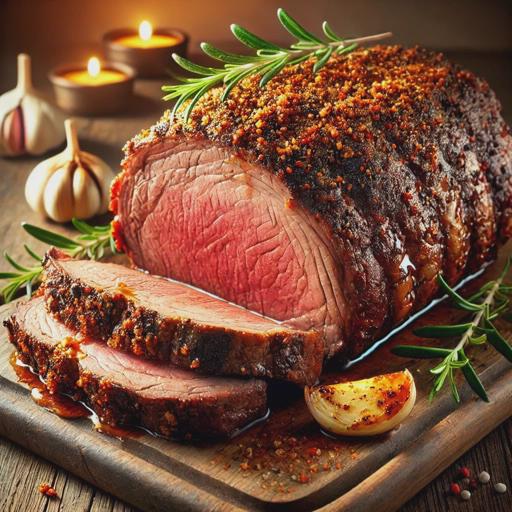
Reverse Sear
The reverse sear method starts with slowly cooking the roast in a low-temperature oven, around 225°F (107°C), until it’s about 10-15°F away from your target temperature. Then, crank up the heat to 500°F (260°C) or use a hot skillet to sear the outside of the roast, creating a beautifully browned crust. This method is excellent for achieving a uniformly cooked interior with a crisp exterior.
Smoked
Smoking a standing rib roast adds a deep, smoky flavor that’s hard to beat. Season as desired and smoke at a low temperature, around 225°F (107°C), until it reaches an internal temperature about 10°F less than your target doneness. Finish by resting the meat, allowing the carryover cooking to bring it to perfect doneness. Woods like hickory or cherry can add unique flavor profiles.
Salt-Crusted
Encasing the roast in a salt crust locks in moisture and flavors. Mix kosher salt with egg whites to create a paste. Cover your seasoned roast entirely with the salt mixture and roast until the internal temperature reaches your desired doneness. The crust is cracked and removed to reveal a juicy, perfectly seasoned roast.
Choosing Your Method
- For traditionalists: The classic oven-roasted method is straightforward and focuses on the meat’s natural qualities.
- For perfectionists: Reverse sear offers precise control over doneness and texture.
- For the adventurous: Smoking and salt-crusted methods introduce unique flavors and techniques.
Each method can produce a spectacular standing rib roast, so consider your guests, available equipment, and flavor preferences when choosing how to prepare your roast.
Okay, my first instinct was to jump on the Salt-Crusted method because I love doing fun stuff. But, I decided to go with the reverse sear method because it’s a bit simpler and more in line with what I had in mind in the first place. Maybe next time I’ll give the Salt-Crusted method a shot.
I have a 7lb, boned and tied standing rib roast. Give me a recipe using the reverse sear method. I want a super flavorful rub, a crispy crust, and a juicy interior. Oh, and I want to use Dijon mustard.
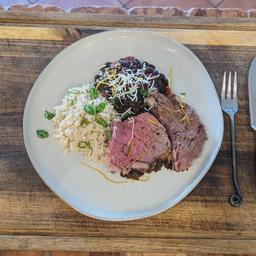
Dijon Mustard & Paprika-Crusted Standing Rib Roast
This Dijon Mustard & Paprika-Crusted Standing Rib Roast uses the reverse sear method to deliver a perfectly cooked, juicy interior with a crispy, flavorful crust. Coated in Dijon mustard and a blend of paprika, rosemary, thyme, and garlic, the roast is slow-cooked to tender perfection, then finished at high heat for an irresistible browned exterior. Ideal for holiday gatherings, this roast is sure to impress your guests with its rich flavors and tender texture.
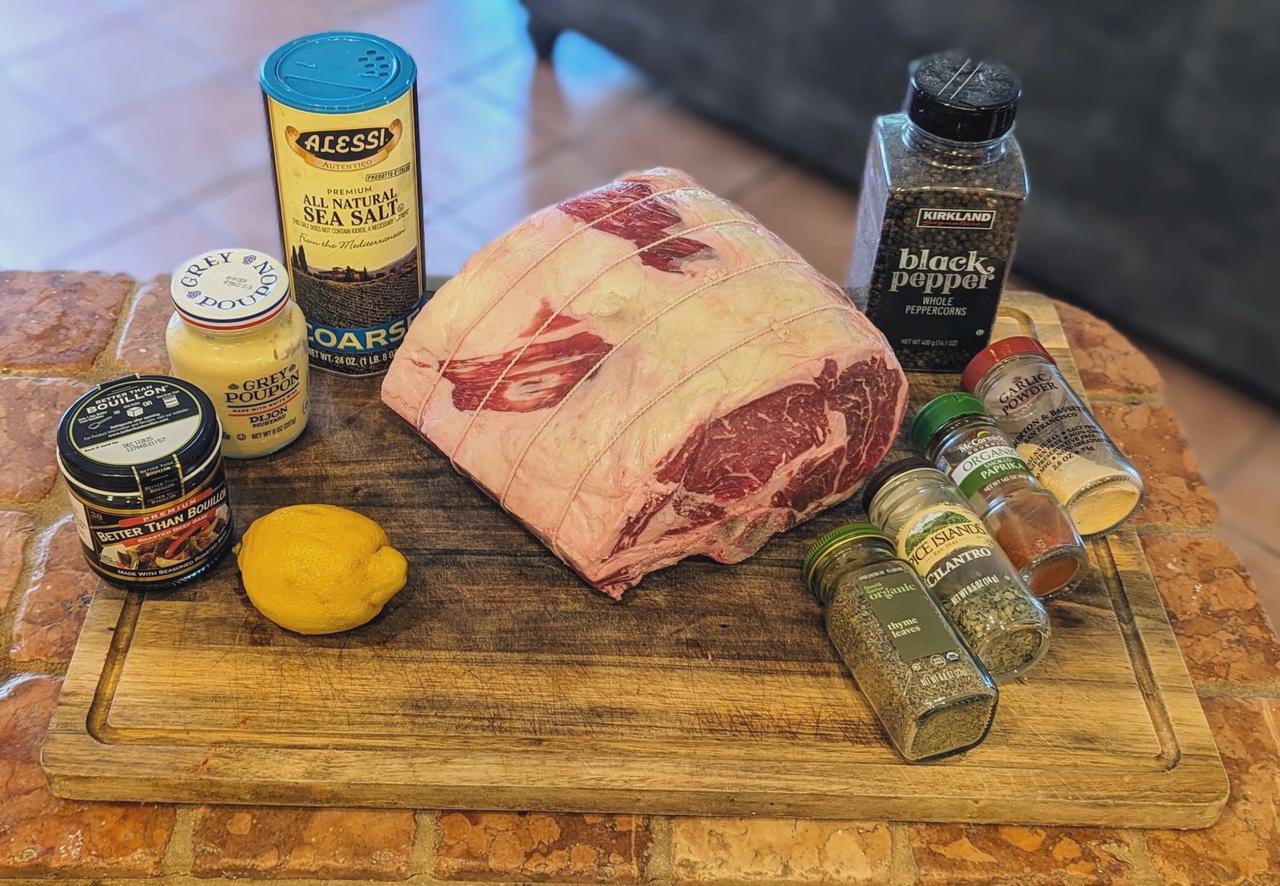
Ingredients
- 1 (7 lb) boned and tied standing rib roast
- Coarse kosher salt (for seasoning)
- 3 tablespoons Dijon mustard
Dry Rub:
- 2 tablespoons dried rosemary
- 1 tablespoon dried thyme
- 1 tablespoon garlic powder
- 1 tablespoon paprika
- 1 teaspoon dried parsley
- 1 teaspoon freshly ground black pepper
Optional:
- 2 cups beef broth (for the roasting pan)
- Zest of 1 lemon
Instructions
- Salt the Roast: Begin by liberally salting the entire surface of the rib roast. This initial seasoning is crucial for flavor development throughout the meat.
- Rest to Room Temperature: After salting, Allow the roast to sit at room temperature for about an hour. This step is essential for the salt to penetrate and season the meat deeply, ensuring even cooking.
- Preheat the Oven: Preheat your oven to 275°F (135°C). This temperature is key for the reverse sear method, allowing the roast to cook gently and evenly.
- Apply Dijon Mustard: Coat the entire surface of the roast evenly with the Dijon mustard. The mustard contains flavor and acts as a binder for the dry rub, negating the need for olive oil.
- Prepare the Dry Rub: In a small bowl, mix the dried rosemary, thyme, garlic powder, paprika, dried parsley, and black pepper. This blend of spices and herbs will create a flavorful crust that complements the meat’s richness.
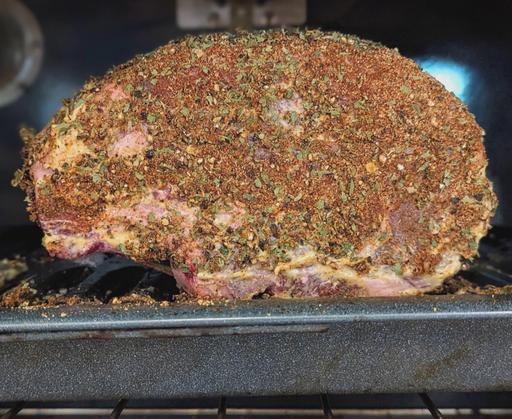
- Rub the Seasonings: Apply the dry rub over the mustard-coated roast, ensuring it’s evenly covered. The mustard will help the dry rub adhere to the meat without additional oil.
- Roast the Meat: Place the rib roast on a roasting pan rack, fat side up. Pour beef broth into the bottom of the pan to add moisture and catch drippings, which can be used for gravy. Roast in the preheated oven for about 175 minutes (25 minutes per pound) or until an instant-read thermometer inserted into the thickest part of the meat reads 125°F (52°C) for medium-rare.
- Rest the Roast: Remove the roast from the oven and tent it loosely with aluminum foil. Let it rest for 30 minutes. This rest period allows the juices to redistribute throughout the meat, ensuring it’s moist and flavorful.
- Increase Oven Temperature: While the roast rests, increase the oven temperature to 450°F (230°C). This high heat is essential for achieving a crispy, browned crust during the final sear.
- Final Sear: After the roast has rested, remove the foil and return it to the oven. Roast for 7-8 minutes or until the exterior is sufficiently browned and crispy.
- Serve: After removing the roast from the oven, let it stand for a few minutes. If desired, zest a lemon over the top for a bright, citrusy finish, then slice against the grain. Serve the beautifully browned, juicy slices to your eager guests.
This meticulously crafted recipe ensures your standing rib roast will be the highlight of your feast. Its tender interior is encased in a flavorful, crispy crust. The Dijon mustard imparts a tangy depth and effectively secures the dry rub. Enjoy the rich, complex flavors that this masterpiece brings to your table.
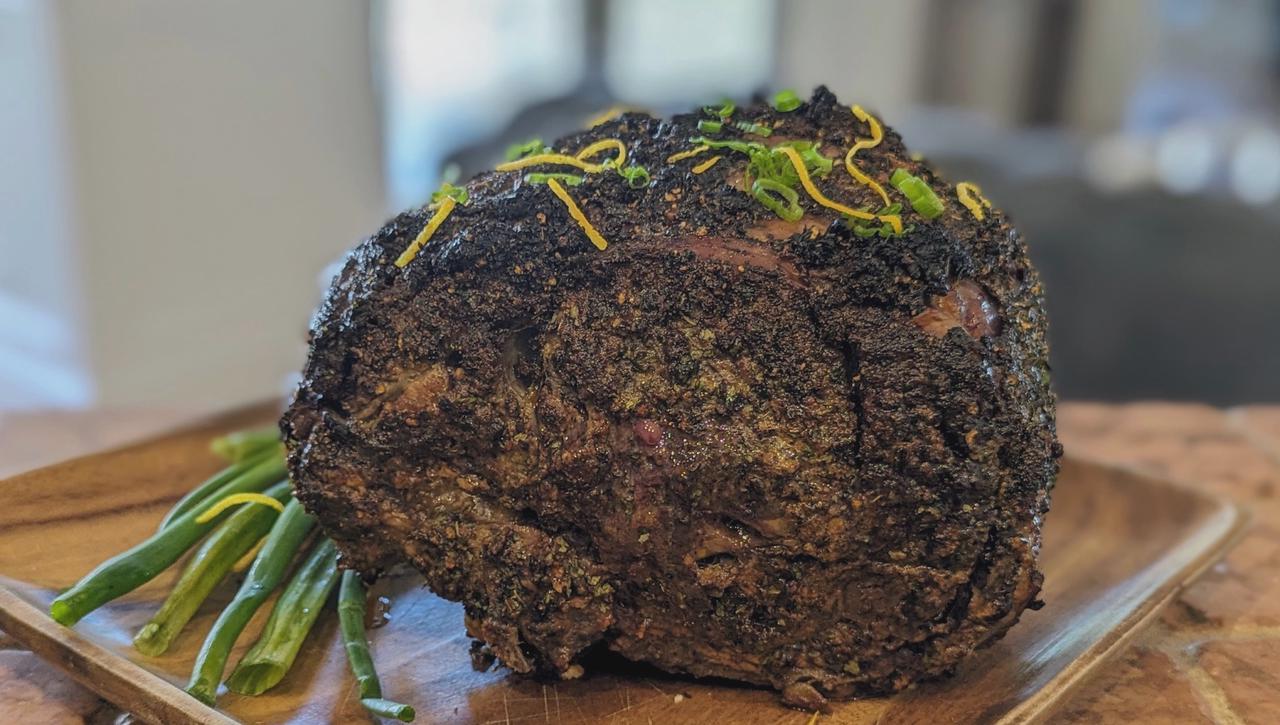
Was It Magical?

It’s criminal that I didn’t give this an “awesome” rating because come on; the interior was perfectly cooked, and the crust was crispy and flavorful.
I served it with some rice and black beans, and it was a hit.
The reason I’m only giving it a “good” rating is two-fold:
- The crust was just a little bit too well done for my liking. I don’t think a reverse sear was needed, but certainly not for as long as the recipe called for. That’s my bad, though, because I should have been checking on it more frequently. Also, I’m the one that asked for it to be cooked this way.
- It was one hell of a roast, but… that’s it. It was just a roast. Awesome Gippity Kitchen recipes are exciting, and this one was too straightforward. Again, this was my fault because I didn’t go with the Salt-Crusted method, or ask Gippity to do anything weird or fun with it.
Anyway, I’m not complaining. It was a great roast, and you should make it. Just keep an eye on it while it’s finishing up in the oven.
